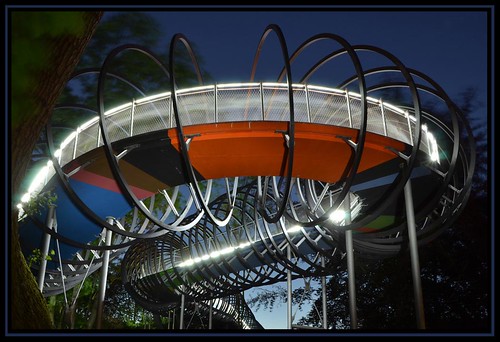Appeal of the Surreal
By Sarah Wilson
A study of how surrealism works on the mind
“It is an irrational architecture which does not fall in
with any ideas of comfort; it is figurative, even metaphorical. Its aim is to
make habitable monumental pieces of sculpture, preferably representing
creatures or objects.” (Sarane Alexandria 1985)
We are
attracted to odd things; it’s in our human nature to be curious. Architects
like Le Corbusier, Tobias Rehberger, and Liz Diller & Ricardo Scofidio took
advantage of this fact when creating some of their works, whether they were
purposely creating under the label of ‘surrealism’ or not. Creations like Le
Corbusier’s Beistegui Apartment, Rehberger’s “Slinky Springs to Fame”
pedestrian bridge, and Diller & Ricardo’s “blur” pavilion each have
elements of surrealism that attract our eye, and those elements are successful
for particular reasons.
 |
| Beistegui roof garden |
A glimpse
at the roof garden in the Beistegui Apartment may summon an image from Alice in Wonderland. The seemingly
ordinary living room, complete with seating, bureau, fireplace, and mirror,
suddenly seems extraordinary when on realizes the material of the ‘carpet’.
This irrational placement of typical indoor furniture in an outdoor setting is
what suggests this garden to be a work of surrealism. Perhaps stranger still is
the high, solid walls juxtaposed with not a hard ceiling, but a soft sky. The
appeal of the Beistegui roof garden is the existence of these unexpected
juxtapositions, which attract attention and render the design successful.
 |
| "Slink Springs to Fame" |
Rehberger’s
pedestrian bridge has an unexpected appearance as well. With a name like “Slinky
Springs to Fame”, there’s little question where Rehberger got his inspiration.
Pedestrians will likely be surprised upon their first encounter with this
bridge, with or without the knowledge of its name. This elevated bridge twists
and winds around a forest of trees, ringed with endless slinky-like loops and
striped with bright colors. Said colors respond to the curve of each bend in
the bridge and glow in the nighttime setting. The surrealism comes with the
super-enlargement of the well-known toy, transforming its previous playtime
purpose to one of function. The success of this piece is the direct
representation of a beloved childhood artifact, combined with the purpose of
connecting two points with a path. Far from being straightforward, the bridge
captures the character of the slinky and dances around the forest from start to
finish. Thus, the appeal of Rehberger’s work is more so the experience than the
end result, much like the slinky—watching it flop down the stairs is far more
exciting than seeing it come to a plopping stop at the bottom.
 |
| 'blur' pavillion |
It wasn’t
a large, low-lying cloud floating over Switzerland’s Lake Neuchatel in 2002.
This ever-changing cloud of mist was the work of Diller & Scofidio, a
temporary pavilion for the Swiss Expo. Constructed over the lake with steel and
13,000 water jets, the ‘blur’ pavilion was a habitable sculpture created from
an infinite number of water droplets. Within this cloud was the Glass Box, a
small field of green contained within glass walls and roof to make visitors
feel suspended in that fog. This habitable sculpture element lends itself to
surrealism, as well as the strange physical experience. It must have seemed
unreal to stand within a cloud, suspended over the surface of the lake, but
there is an appeal to this experience in its uniqueness. There a few chances
for humans to stand within clouds, and the ‘blur’ pavilion provided this
surreal experience, and so it was successful.
We can’t
often help ourselves when presented with something strange. If an object,
place, or experience seems new or alien, our curiosity often overwhelms
rational thought. The irrational, metaphorical, and unexpected qualities of
surrealism make it appealing to many. This partially explains the success of the
Beistegui apartment roof garden, the “Slinky Springs to Fame” bridge, and the ‘blur’
pavilion—each offered an experience that was strange but imaginative, and they
attracted attention. Whether their architects meant for these pieces to be
surreal or not, the elements are there, and they work.
Works cited:
Sarane Alexandria, . Surrealist Art. Thames & Hudson,
1985.
No comments:
Post a Comment